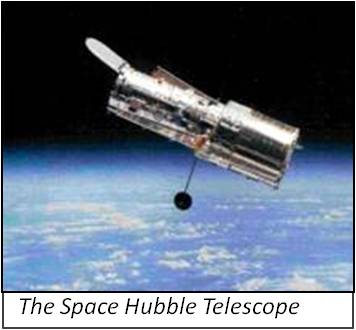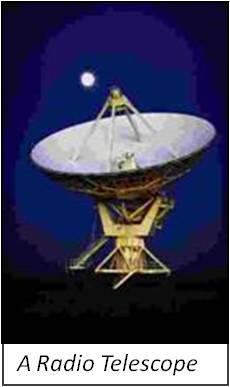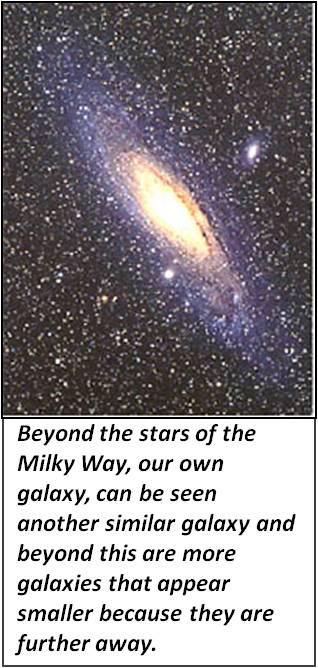
God in Creation Part 1 – DISCOVERING THE UNIVERSE
THE CONSISTENT CLAIM of the Bible is that everything in the universe was created by an all-powerful and supremely wise being called God:
“In the beginning God created the heaven and the earth” [Genesis 1.1].
“The LORD by wisdom hath founded the earth; by under-standing hath he established the heaven” [Proverbs 3.19].
“…God, which made heaven, and earth, and the sea, and all things that are therein” [Acts 14.15].
However many people ask the question: ‘Are such claims made several thousand years ago, to be taken seriously in view of the immense increase in knowledge and understanding of nature and the universe that man has gained in recent years?’ In this section we will review some of the discoveries scientists have made, leaving you to judge whether these findings make God unnecessary and irrelevant, or whether it becomes more reasonable to believe in the existence of an intelligent designer and controller. Are belief in God and scientific discovery necessarily in conflict?
DISCOVERING THE UNIVERSE
Dotted around the world, usually on the summit of high mountains above the pollution and distortion of the earth’s atmosphere, are a number of astrophysical observatories. These very specialised buildings contain huge telescopes that peer out into space with such magnification that they could spot a small coin on the moon, or measure the thickness of a hair fifty miles away. Special cameras take pictures and other instruments record and analyse the light coming from the heavenly bodies. Where light cannot penetrate the vast areas of interstellar dust a special infrared telescope – so sensitive that it can detect the heat of a candle flame a long distance away – pinpoints the presence of unseen bodies in space.
distortion of the earth’s atmosphere, are a number of astrophysical observatories. These very specialised buildings contain huge telescopes that peer out into space with such magnification that they could spot a small coin on the moon, or measure the thickness of a hair fifty miles away. Special cameras take pictures and other instruments record and analyse the light coming from the heavenly bodies. Where light cannot penetrate the vast areas of interstellar dust a special infrared telescope – so sensitive that it can detect the heat of a candle flame a long distance away – pinpoints the presence of unseen bodies in space.
The universe also abounds in radio waves emitted from distant stars that readily penetrate our atmosphere and can be picked up by the massive bowls of radio telescopes that are dotted around the world.
 To avoid the problems caused by our weather and atmosphere, there are also flying observatories, notably the Hubble telescope, packed with computer-driven instruments that record the heavens from the comparatively dry and clear atmosphere miles above the earth.
To avoid the problems caused by our weather and atmosphere, there are also flying observatories, notably the Hubble telescope, packed with computer-driven instruments that record the heavens from the comparatively dry and clear atmosphere miles above the earth.
THE UNIVERSE HAS A STRUCTURE
All these investigations have convinced astronomers that firstly, the universe is of inconceivably immense size. Secondly, the heavenly bodies are not spread out uniformly in space but are in a series of groups. The basic unit in each group is a star, of which our Sun is an average specimen. The Sun has the Earth and other planets in orbit around it. The stars we can see on a clear night are only the Sun’s immediate neighbours in space. The nearest star is 25 trillion miles away and light from it, travelling at 186,000 miles per second takes about 4.3 years to reach us – i.e. at a distance of 4.3 light-years. To help you better envisage this distance, if the distance from the Earth to the Sun (93 million miles) were represented by one inch, then the nearest star would be four miles away.
This distance is small in astronomical terms. On a clear night the Milky Way can be seen as a bright hazy band across the sky. With a telescope the Milky Way is seen as millions upon millions of stars, each like our Sun. This cluster of stars is called a galaxy and is a mass of stars formed into a flat disc about 100,000 light-years in diameter. Our Sun with its solar system and the comparatively few stars we can see with the naked eye, are situated towards the edge of this galactic disc.
bright hazy band across the sky. With a telescope the Milky Way is seen as millions upon millions of stars, each like our Sun. This cluster of stars is called a galaxy and is a mass of stars formed into a flat disc about 100,000 light-years in diameter. Our Sun with its solar system and the comparatively few stars we can see with the naked eye, are situated towards the edge of this galactic disc.
At one time our galaxy was thought to be the entire Universe but it is now known to be but an infinitely small part of it. There are millions of other galaxies organised in groups. In what is prosaically styled our ‘local group’ are about 20 galaxies but this is a comparatively small group. About 50 million light-years away is a group that contains thousands of individual galaxies.
Your mind may be reeling at the magnitude of all this – but we have not yet described the Universe. These groups of galaxies are themselves aggregated into superclusters of about 150 million light-years across. A large number of these superclusters, separated from each other by immense distances, form the observable Universe.
This then is the modern concept of the Universe. We could summarise our relationship to it as follows:
| The | UNIVERSE | contains |
| many | SUPERCLUSTERS | each of which contains |
| many | GROUPS | each of which contains |
| many | GALAXIES | each of which contains |
| billions of | STARS | one of which is our |
| SUN | which has a planet called | |
| EARTH |
THE ORIGIN OF THE UNIVERSE
One of the discoveries about the Universe is that all the clusters of galaxies appear to be moving away from some central point like the debris from an explosion. This has given rise to the ‘big bang’ theory of the origin of the Universe, which is accepted by many, although not all scientists. Physicists have been speculating on a sequence of events that might have led to the formation of the universe. They suggest that originally matter did not exist; there was only an atom-sized nucleus of pure energy. For some unknown reason, this pent-up energy nucleus rapidly began to expand.
The result of this expansion was to convert energy into matter. First came very small subatomic particles, then simple atoms such as hydrogen and helium. With further expansion more and more complex atoms were formed, gradually producing the array of chemical elements present today. These newly formed substances condensed into galaxies and into individual stars but their momentum was maintained and they are still all racing away from that original point of expansion.
NOT COMPLETELY RANDOM
This much-abbreviated account of the theory of the origin of the Universe (and it is still only a theory) may give the impression that its creation was the inevitable consequence of a purely random chain of events. However this is not so. If the Universe did develop in this way, then there had to be very fine control of the original ‘explosion.’ If the newly created Universe had been too dense, gravitational forces would have made it collapse back into itself. If the matter had been too diffuse it would not have condensed into galaxies and stars. The rate of expansion had to be just right. As one physicist put it: ‘To get a Universe that has expanded as long as ours has without either collapsing or having its matter coast away would have required extraordinary fine-tuning.’ 1 This same scientist calculated that the odds of achieving that kind of precise expansion would be the same as throwing a microscopic dart across the Universe and hitting a bull’s-eye one millimetre in diameter.
So the first thing that astronomy tells us is that although all the components and mechanisms for the formation of the Universe can possibly be explained by science, if this was its origin, then it was not just an accident. First an original ‘big bang’ had to be triggered. In any fantastically violent creation event that followed, there had to be precise control if the Universe was to survive.
How was it controlled? Who threw that metaphorical dart and hit the bull’s-eye against all the odds? Is the Divine claim through the prophet Isaiah that outdated after all? The prophet wrote:
“I have made the earth, and created man upon it: I, even my hands, have stretched out the heavens, and all their host have I commanded” [Isaiah 45.12]
Reference
1National Geographic Magazine, Volume 163 number 6, page 741.
THE PURPOSE OF THE UNIVERSE
With a Universe so vast, it seems almost presumptuous that puny man should enquire about its purpose. Yet on a purely scientific level – and there are obviously other possible levels of understanding – it is thought that the original expansion and the immensities of space were necessary requirements for the production of the elements needed for life. ‘Some scientists are arguing seriously that this forbiddingly large and existential Universe was absolutely necessary for life to evolve. The elements of life had to be cooked up in stars… The Universe had to be rapidly expanding all that time. The Universe has to be large for life to have evolved.’ 2
As you will gather from reading this issue of ‘Light on a New World’, the author does not agree that life has evolved but that it was created. Leaving that aside for the moment, the point we are making, is that scientific discoveries not only indicate some control in the formation of the Universe, but also the end product of this process produced the raw materials which we now know are the components of living things. Nearly three thousand years ago the Bible expressed the same idea that the earth was created as a receptacle for life:
“For thus saith the LORD that created the heavens; God himself that formed the earth and made it; he hath established it, he created it not in vain, he formed it to be inhabited…” [Isaiah 45.18].
As we end this brief review of the current scientific thinking on the Universe we can confidently say that these discussions do not rule out the existence of an all-wise and powerful Creator. Indeed, they almost demand His existence.
Reference
2National Geographic Magazine, Volume 163 number 6, page 745.
More Articles in this Series are listed below:
God in Creation Part 1 – DISCOVERING THE UNIVERSE
God in Creation Part 2 – LIFE ON EARTH
God in Creation Part 3 – THE THEORY OF EVOLUTION EXAMINED
God in Creation Part 4 – THE EVIDENCE OF GEOLOGY
God in Creation Part 5 – MAN IN THE IMAGE OF GOD
![]()
